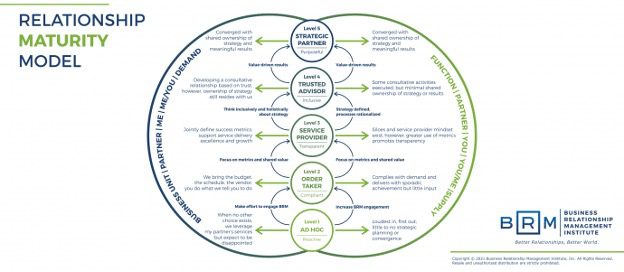Business relationship management is a business framework that strategically nurtures positive relationships to achieve three capabilities: driving value, building partnerships, and evolving culture. In part three of this series, we’ll focus on applying it to build effective partnerships.
In today’s interconnected and dynamic business landscape, the success of organizations heavily relies on the strength of their relationships. The business relationship management (BRM) framework can help you build partnerships that foster shared ownership, trust and mutual respect, a vital component of achieving sustainable results.
In this installment of our blog series on the basics and benefits of BRM, we’ll explore the importance of cultivating high-quality partnerships, the mindset required to build them, and a framework to help organizations nurture and mature these partnerships.
How Partnerships Drive Value
Building partnerships means cultivating and advancing positive relationships characterized by shared ownership of risks, responsibilities and resources and a shared goal of achieving successful, impactful outcomes. Every organization has an intricate web of working relationships – some of which stand out as exceptional, genuine partnerships that resonate with each person involved.
According to a recent article in the Harvard Business Review, data from the field of social psychology demonstrates that leaders who prioritize relationships with their employees and lead from a place of positivity and kindness simply do better.
The most effective leaders of all (as measured by their success rates and the success of their organizations) are values-driven, transparent, compassionate, humane, and recognize employees as unique individuals. As a result, their employees perform better, too. They are more engaged, less likely to turn over, more loyal, and more productive. Companies run by these types of leaders enjoy higher client satisfaction, a better bottom line, and boosted shareholder returns.
In these exceptional partnerships, all parties understand and appreciate the relationship’s context, instilling a collective sense of unity and purpose. This understanding helps all parties feel like they are working together towards a common goal.
It’s also important these partnerships have a sense of equality. This does not imply that all individuals are equal in every aspect but that each person brings a unique combination of knowledge, insight, perspective, talent, and cognitive styles that contribute to the richness of the work relationship. In true partnerships, both individuals feel respected and actively engage their growth mindsets, constantly learning from one another.
While you cannot solely attribute responsibility for individual relationship quality to the BRM capability, its role lies in fostering a rise in the quantity and quality of partnerships. They achieve this improvement by cultivating widespread adoption of business relationship management concepts and partnering mindsets throughout the organization.
When a substantial portion of the network comprises partnerships, the organizational culture evolves into an open community that prioritizes learning, sharing and positive collaboration. An organization emphasizing partnership-building keeps up with ever-present change and experiences continuous growth. This collective growth becomes embedded within subsequent relationships, establishing an ongoing cycle of continuous development. As a result, the organizational culture becomes invigorated with heightened energy, creating significant value.
The Role of Business Relationship Managers in Creating Partnerships
Business relationship managers (BRMs) are responsible for fostering exceptional partnerships across their entire organization. To accomplish this, they must employ techniques to establish strong, effective relationship networks, such as these examples:
Relationship Maturity Measurement
The BRM Institute’s Relationship Maturity Model is a diagnostic tool that allows you to comprehensively assess the maturity levels of relationships across your organization. This model illustrates a continuum of relationship maturity consisting of five levels.
At level one, relationships function ad-hoc due to their reactive nature. At level five, relationships operate on a strategic partner basis, where all parties share a deep appreciation for each other’s contributions that help fulfill organizational purpose.
Relationship Strategy on a Page (RSoaP)
The relationship strategy on a page (RSoaP) is a technique that promotes mutual understanding regarding desired results and the necessary means to achieve them. This technique helps establish a shared vision and expectations for the relationship between partners and functions, typically through collaborative workshops. The workshops focus on clarifying commitments and expectations from both parties and outlining a roadmap of initiatives required to reach targeted outcomes together.
By the end of the workshop, the business relationship manager has successfully facilitated the process of defining and achieving mutual agreement on how the organization will establish a strong partnership. This includes collaboratively diagnosing the relationship, creating a shared vision, identifying key relationship characteristics, outlining performance measures for the partnership, cataloging essential initiatives, and defining operating principles.
During quarterly business reviews (QBRs), the RSoaP is comprehensively reviewed to assess the progress and realization of the agreement made during the workshop.
Partner Value Hierarchy (PVH)
Inspired by the Kano Model, this technique focuses on differentiation rather than solely addressing customer needs to provide valuable insights into the key characteristics of products or services that hold significance for partners.
The PVH helps specify and improve products and services by classifying partner needs into three categories:
- Table Stakes: Represents essential partner requirements, which are indispensable for meeting higher-order value expectations.
- Satisfiers: Represents services or products that partners may typically expect but can do without.
- Differentiators: Represents surprising elements that have the greatest impact on a partner’s perception of value creation.
Relationship Improvement Plans (RIP)
This technique leverages the partner value hierarchy (PVH) to guide the planning and enhancement of working relationships, aiming to maximize business value from provider investments and assets. The RIP serves as a documented framework for addressing specific actions to overcome identified weaknesses and unmet expectations, as the PVH outlines.
In any critical relationship, it is essential to identify expectations people can reasonably meet. However, there may be instances where meeting a particular expectation does not align with the value received, cost involved, or effort required. In such cases, it presents an excellent opportunity to engage with the leader and openly discuss the stated needs. Remember, striving to avoid being perceived as mere “order takers,” contributing teams should feel confident engaging with the leader throughout this process.
Typically, the RIP is not shared with the business partner, but there is no reason why it couldn’t be collaboratively shared and implemented. Being transparent about your intention to lead an effort while seeking to improve the relationship will likely result in the business partner receiving the plan well.
To ensure effective communication, be proactive in sharing the progress and results of this effort with the business partner. During regular meetings, include a pulse check to gauge how they perceive the ongoing efforts to improve the overall relationship.
Conclusion
When exceptional partnerships dominate an organization’s network of relationships, its culture evolves into an inclusive community that values learning, sharing and positive collaboration. In this environment, individuals are empowered to exchange knowledge freely and collaborate effectively.
As stewards of relationships, business relationship managers play a vital role in cultivating and nurturing partnerships across the organization. Ultimately, a network of strong partnerships allows organizations to adapt to change, maximize value creation, and thrive in an ever-evolving business landscape.
By actively fostering partnerships, an organization demonstrates its ability to embrace and navigate the constant flux of change, enabling it to achieve ongoing growth and continually venture into new realms of success.


